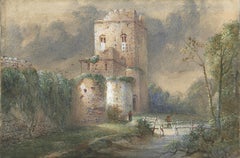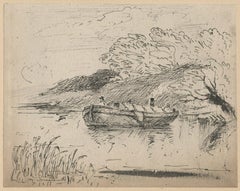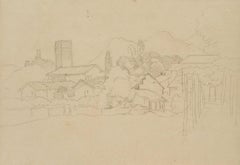David Cox Art
David Cox was born at Deritend, near Birmingham, in 1783, as a son of a blacksmith. In around 1798, aged 15, he was apprenticed to a miniature painter named Fieldler. Following Fieldler's suicide, Cox was apprenticed around 1800 as an assistant to a theatre scene-painter named De Maria. In 1804, he took work as a scene-painter with Astley's Theatre and moved to London. By 1808, Cox had abandoned scene-painting, taking water-color lessons with John Varley. In 1805, he made the first of his many trips to Wales, with Charles Barber; his earliest dated watercolors are from this year. Throughout his lifetime, he made numerous sketching tours to the home counties, North Wales, Yorkshire, Derbyshire and Devon. Cox exhibited regularly at the Royal Academy from 1805. His pictures never sold for high prices, and he earned his living chiefly as a drawing-master. Through his first pupil, Col. the Hon. H. Windsor (the future Earl of Plymouth), who engaged him in 1808, Cox acquired several other aristocratic pupils. He wrote several books, including Ackermann's New Drawing Book (1809); A Series of Progressive Lessons (1811); Treatise on Landscape Painting (1813) and Progressive Lessons on Landscape (1816). The ninth and last edition of his Series of Progressive Lessons was published in 1845. In 1810, he was elected President of the Associated Artists in Watercolor. In 1812, following the demise of the Associated Artists, he was elected an Associate of the Society of Painters in Watercolor (Old Watercolor Society). Cox was elected a Member of the Society in 1813, and exhibited there every year except 1815 and 1817, until his death. In about 1814–15, he was appointed drawing-master at the Military Staff College, Farnham. With his appointment as drawing-master at Miss Croucher's girls' school, he took up residence in Hereford. He made his first trip to the Continent, to Belgium and Holland, in 1826 and moved to London the following year. He exhibited for the first time with the Birmingham Society of Artists in 1829, and with the Liverpool Academy from 1831. In 1839, two of Cox's watercolors were bought from the Old Watercolor Society exhibition by the Marquis of Conyngham for Queen Victoria. Around 1840, Cox took up oil painting, studying under W.J. Müller (1812–45). Cox exhibited two oil paintings at the Royal Academy in 1844. From 1844–56, he spent summers at Betws-y-Coed, in North Wales. His health suffered following a stroke in 1853. In 1855, he was represented by watercolors at the Paris Universal Exhibition. By 1857, however, his eyesight had deteriorated. An exhibition of his work was arranged in 1858 by the Conversazione Society, Hampstead, and in 1859 a retrospective exhibition was held at the German Gallery, Bond Street, London. Cox died several months later. He was buried in Harborne, near Birmingham, where he had retired in 1841.
Late 19th Century David Cox Art
Watercolor
Mid-19th Century David Cox Art
Watercolor
1840s Romantic David Cox Art
Watercolor
1810s Romantic David Cox Art
Ink
19th Century Romantic David Cox Art
Paper
18th Century Romantic David Cox Art
Gouache, Paper
Late 19th Century Romantic David Cox Art
Paper, Ink
Mid-19th Century Romantic David Cox Art
Watercolor, Pencil, Paper
1860s Romantic David Cox Art
Carbon Pencil, Gouache
1760s Old Masters David Cox Art
Ink, Watercolor
Early 19th Century Romantic David Cox Art
Watercolor, Laid Paper
2010s Contemporary David Cox Art
Ink, Watercolor, Archival Paper
2010s Romantic David Cox Art
Watercolor, Paper
19th Century Romantic David Cox Art
Paper, Watercolor
1970s Ashcan School David Cox Art
Watercolor
18th Century Romantic David Cox Art
Gouache, Paper
1850s David Cox Art
Canvas, Oil
1830s Victorian David Cox Art
Watercolor
Early 19th Century Impressionist David Cox Art
Watercolor, Paper






